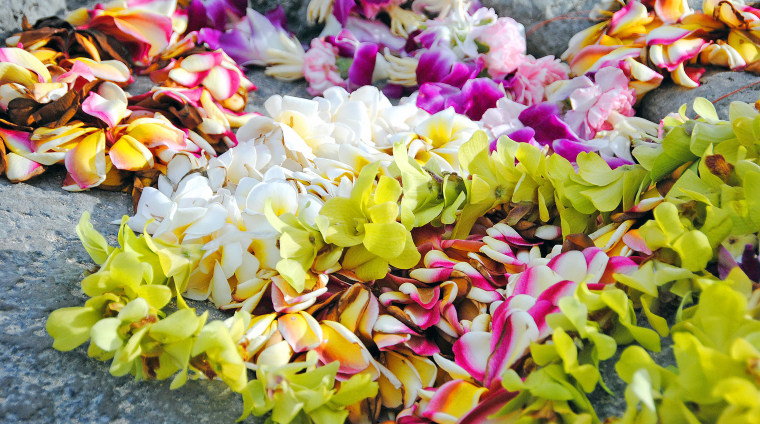Hearing the word "Hawaii" may drum up visions of ocean waves, soft sand and, of course, colorful flower necklaces, known as lei.
A fresh flower lei is synonymous with a Hawaiian greeting and is part of daily life across the Hawaiian Islands.
"Lei is worn every day in Hawaii," Luana Maitland, director of cultural experience at Outrigger Resorts, tells TODAY.com. "(It can) celebrate birth, marriage, graduations, promotions (or) the celebration of life."
Maitland says she grew up learning to make lei, "just like learning how to read."
"By age 2, I was given a lei needle to make a lei. I wasn’t given instructions, and just had to watch my tūtū (grandmother) as she made lei to give someone," Maitland says. "She was always making lei."
The making and giving of lei is so special in Hawaii that there is an entire day dedicated to it each year on May 1: Lei Day.
What is Lei Day — and why is it celebrated in Hawaii?
In 1927, American poet Don Blanding wanted to celebrate the idea of making, giving and wearing lei.
"He proposed the idea to Honolulu Star-Bulletin editor Grace Tower Warren who loved the idea," Maitland explains. "She suggested the celebration."
May Day became Lei Day in Hawaii in 1928 with a celebration in Honolulu.
Lei Day received official recognition in 1929 by Governor Wallace R. Farrington, who declared May 1 of each year as "May Day is Lei Day in Hawai‘i."
Blanding expounded on the importance of the holiday in his book, “Hula Moons,” which published in 1930.
“The custom of weaving and wearing flower leis originated with the Hawaiians so long ago that they have no record of its beginning... When tourists discovered Hawaii, they loved the charming gesture and they spread the word of it until the lei became known around the world.
“Hawaii observed all of the mainland holidays as well as those of a number of the immigrant nationalities in the Islands. But there was no day that was peculiarly and completely Hawaii’s own; that is none that included all of the polyglot population there,” he wrote.
In 2001, Senator Daniel Kahikina Akaka, the first Native Hawaiian to serve in the U.S. Senate, called Lei Day "a nonpolitical and nonpartisan celebration."
Why is Lei Day important?
Lei Day celebrates the spirit of aloha and proves that the meaning of a lei goes beyond flowers on a string.
Maitland tells TODAY.com the tradition of lei making spans decades.
“My dad was the eldest of thirteen kids. Many times he and his siblings were invited to a party, so grandma had them pick flowers from the yard and make a lei to be gifted,” Maitland says, adding lei represent love, friendship and celebration. “If she knew the elder of the person celebrating, she would have a second lei made for that elder as respect to the host.”
It’s a tradition that continues today in her family and many others.
“I was babysitting my granddaughter, who was 1 at the time, and needed to make a lei for a dinner I was going to,” Maitland says. “I had her in her highchair while sewing lei and put some flowers on her tray. She picked up the flower and took it to her nose, not her mouth. I knew then that she will love making lei. I took video of her stringing her first pikake lei at 3 and now at 6, she is learning how to care for the pikake plant she is growing in her yard.”
Lei Day celebrations are held across the Islands, as well as in schools for children and at hotels for tourists. On Oahu, this year’s 95th Annual Lei Day Celebration will be held at Queen Kapiolani Park, and will include music, lei-making, hula, parades and introductions of the Lei Court, as well as the Lei Day Queen.
Maitland tells TODAY.com that Lei Day also offers an opportunity to gather lei makers from all over the Islands to come share their technique in lei making.
“Awards are given to the best lei in various categories, sorted by color theme, scent, lei haku, lei wili, lei hulu (feathers), lei for the papale (hat),” she says.
"Aunty Luana" as she is known in her role preserving Hawaii's culture, tells TODAY.com the best thing to remember about Lei Day is, "Make a lei, wear a lei and give a lei.”











